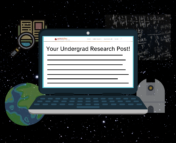If you’ve decided to apply to grad school, you probably already know that the personal statement or Statement of Purpose is the centerpiece of any application (if not, check out these two astrobites). It narrates the different components of your application and establishes you as a person: your motivation, how you got to where you are, and your goals during grad school and after. It’s so important that it’s often daunting to write. That’s ok; take a breath. I’ve covered some basic academic writing tips in a previous article, and they also apply to grad applications. In this article, though, I want to offer some specific advice on how to write an effective personal statement.
Pre-writing and time management
Writing is hard, especially when you have not found your strategy. If you tend to procrastinate until a deadline, you can utilize that adrenaline rush by setting some earlier deadlines for yourself (e.g. promise your advisor to send it by a date). If staring at a blank page puts you off, then start writing an outline and expand from there. Instead of trying to write one perfect sentence after another, allow yourself to write bad first drafts and heavily edit later. The point is not to judge yourself, but to find something that works for you. Your goal: produce a draft that you can work on and get feedback from others before the final deadline.
The introduction (usually one paragraph)
I take out my stack of folders from my desk and remove the top one. This will make number ten today. I struggle to hold back a yawn as I open the manilla folder but refrain from getting up to make more tea. I have already finished two cups and doubt that a third would make much difference. Besides, I have to finish reviewing these grad applications by the end of the day. Unfortunately, my brain doesn’t cooperate, and as soon I start reading, my eyes glaze over. Wait, haven’t I read this one already?
adapted from a Yale Graduate Writing Lab handout by Adriana Cherskov.
Begin with a hook. This achieves the dual purpose of engaging the tired admissions committee reader while setting your personality apart from all the other applicants. Try to begin with a significant moment that impacted you, and something unique. Specifically for astronomy, that means that “I fell in love with astronomy when I looked through a telescope in my backyard when I was thirteen” is unfortunately a cliche. It may very well be life-changing for you, but it’s too common in astro essays to make you stand out.
End this paragraph with a thesis statement that clearly states your research interests. The main argument in the personal essay is why you are a good candidate for this program, and the compelling evidence should come from your research interests and experiences. Stating it early on will help the reader understand what sub-field you are in and put you under the appropriate tag.
The body (3-5 paragraphs)
Each paragraph should have a topic sentence that summarizes the project you worked on. Mention the lab or PI and general topic, so that someone skimming the essay can still get a sense of what you learned or achieved in each project. Since PhD programs are research-oriented, the body paragraphs should establish that you are a competent researcher who understands the science and can carry a project to completion. Towards that goal, each body paragraph should also have the following three components:
- One sentence or two on the scientific motivation of the project. If you developed a detection algorithm for neutron stars, first you need to explain why you want to find neutron stars or why we need a new way to do it. Even if you didn’t know this when you started a project, now is the time to show that you understand how it fits into the big picture.
- Several sentences describing your contribution to the project. Use simple, clear language and avoid too many technical details. Try to start the sentence with “I” instead of “we” and clearly identify your work. Make sure to define any terms and jargon. If you’re not sure, give your essay to someone in another subfield and see if they got it.
- Describe the result of your project. This can be a paper, a conference presentation, a thesis, a data product, or a finding. Really, it can be anything that signals that you reached an endpoint and achieved something.
If there’s anything you want to highlight or explain about your academic career so far (e.g. if you had some significant disruptions to your studies that show up elsewhere in your application), spend a paragraph on that. This is one space you get to tell the admissions committee whatever you want them to know.
The conclusion (1 paragraph)
Usually the last paragraph of the personal statement ties your research interests to a particular department or program. The key thing to do here is to identify some faculty that you can potentially work with. Before you write about Prof. X, make sure that this faculty is still actively doing research and mentoring students (e.g. by checking their recent publications or emailing people). In the conclusion paragraph, summarize the relevant work from Prof X. and say why this is a good fit for you. Do this for at least two faculty members that you can see yourself working with. When the admissions committee is considering you, they also need to know that someone can be your advisor after you come here, so give them more than one option to be safe.
How to revise
After you write your essay, show it to other people. Find some friends who are not in your subfield, or better yet, someone who has gone through the application process. Also make sure that the content in the essay matches with your letters of recommendation, and sometimes letter writers ask to read your essay. My suggestions and feedback from others hopefully give you a place to start if you feel lost. At the end of the day, the personal statement should be unique, so be creative and make it your story.
Astrobite edited by Viraj Karambelkar
Featured image credit: Zili Shen



